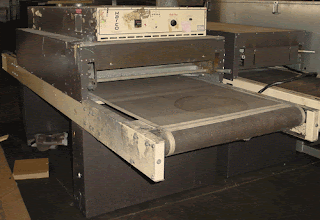Machinery maintenance
After the windows, floors, bathrooms and showroom are polished it is time to work on the machines that earn you money. If they are not in excellent working order, then you are not going to make the money you should in the future months.
Let's start with your dryer. Large or small, a screen print shop's production is all dependent on the functioning of the dryer. So your first task is to clean your dryer. You should check all of these items:
- Heating elements. If you have quartz elements, make sure they are clean. If you have cal-rod or brick type then just confirm that they are all functioning.
- Fans. Exhaust fans, intake fans, cooling fans. Are they clean and functioning?
- Filter systems. When is the last time you really checked and cleaned those? Now be honest.
- Drive system. The motor, chain and gears should be clean of lint and re-secured.
- Control panel. Yes, you have to clean those. Get your shop vac out and suck up all that lint that is in the panel.
- Gas train. Are all your fittings secure?
Now we can move onto your printers. These are what you have your hands on every day. If you have used a hammer or a pair of pliers on any of your presses within the last month, then you have serious work to do.
- Re-level the press. This does not mean using a carpenter's level. Confirm with your machine manufacturer's instructions on leveling your press. This will take some time but it is well worth the effort. It will pay off in future set-ups.
- Replace and repair all parts. No more burnt platens. No more bungee cords, no more pliers for knobs. Having a press that functions well will speed up production and earn you more money.
Spin 360° around your shop. See all those other pieces of machinery that you need? Fix and clean them. Do not procrastinate because you will be ticked off during your next print run that you did not fix the problem when you had time.
Parts inventory.
Large production houses determine which parts they should own for all the machinery in their shop. They do this at the time of purchase and often have stock on their shelves. This means minimal down time in the future. Now, they have larger budgets than most but there are some "rules" that can help you decide what you should have.
- Is there a part on any machine that is difficult to get or has a long lead time? If so, stock one.
- Are there parts on the machine that if broken, will shut down your operation? If so, stock one. One that comes to mind is a motor and motor control for any dryer that is over 3 years old. This is service experience talking. I can bypass most parts in a conveyor oven, but not a DC drive motor.
- If you run an automatic, what are the essentials. What air parts are essential? Any boards that you should have?
- Screen processing equipment. If you do not have a bulb for your exposure unit on your shelf, you should be ashamed. It is not as if you can get them from Home Depot and you are not really going to use the sun in a case of desperation.
Spin 360° around your shop. See all those other pieces of machinery that you need? Consider what parts are essential and buy them.
The cost.
Really, there isn't any. Yes, there is some initial out of pocket expense. But what is the cost of down time. Way more than this little bit of time and inventory.
Enjoy your cleaning. It is a quiet time of reflection of the great work you have done and preparing for future growth.


